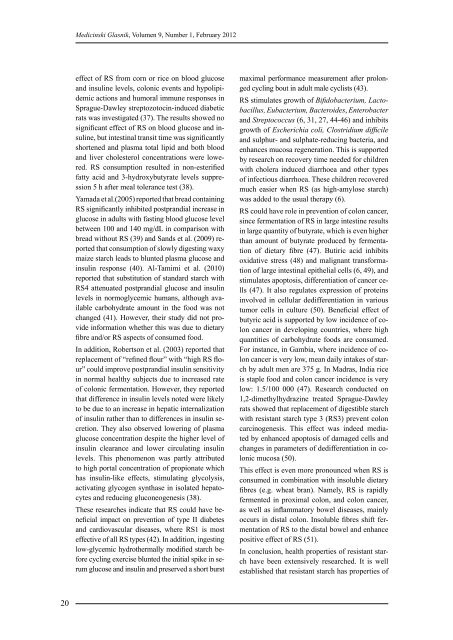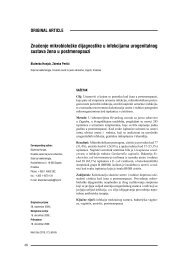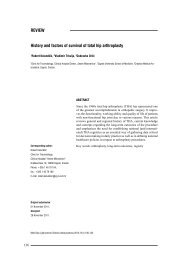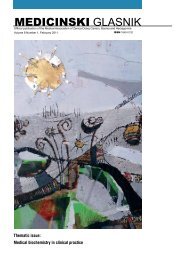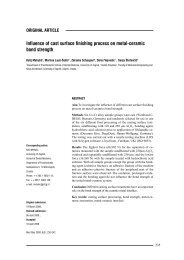MEDICINSKI GLASNIK
MEDICINSKI GLASNIK
MEDICINSKI GLASNIK
You also want an ePaper? Increase the reach of your titles
YUMPU automatically turns print PDFs into web optimized ePapers that Google loves.
20<br />
Medicinski Glasnik, Volumen 9, Number 1, February 2012<br />
effect of RS from corn or rice on blood glucose<br />
and insuline levels, colonic events and hypolipidemic<br />
actions and humoral immune responses in<br />
Sprague-Dawley streptozotocin-induced diabetic<br />
rats was investigated (37). The results showed no<br />
significant effect of RS on blood glucose and insuline,<br />
but intestinal transit time was significantly<br />
shortened and plasma total lipid and both blood<br />
and liver cholesterol concentrations were lowered.<br />
RS consumption resulted in non-esterified<br />
fatty acid and 3-hydroxybutyrate levels suppression<br />
5 h after meal tolerance test (38).<br />
Yamada et al.(2005) reported that bread containing<br />
RS significantly inhibited postprandial increase in<br />
glucose in adults with fasting blood glucose level<br />
between 100 and 140 mg/dL in comparison with<br />
bread without RS (39) and Sands et al. (2009) reported<br />
that consumption of slowly digesting waxy<br />
maize starch leads to blunted plasma glucose and<br />
insulin response (40). Al-Tamimi et al. (2010)<br />
reported that substitution of standard starch with<br />
RS4 attenuated postprandial glucose and insulin<br />
levels in normoglycemic humans, although available<br />
carbohydrate amount in the food was not<br />
changed (41). However, their study did not provide<br />
information whether this was due to dietary<br />
fibre and/or RS aspects of consumed food.<br />
In addition, Robertson et al. (2003) reported that<br />
replacement of “refined flour” with “high RS flour”<br />
could improve postprandial insulin sensitivity<br />
in normal healthy subjects due to increased rate<br />
of colonic fermentation. However, they reported<br />
that difference in insulin levels noted were likely<br />
to be due to an increase in hepatic internalization<br />
of insulin rather than to differences in insulin secretion.<br />
They also observed lowering of plasma<br />
glucose concentration despite the higher level of<br />
insulin clearance and lower circulating insulin<br />
levels. This phenomenon was partly attributed<br />
to high portal concentration of propionate which<br />
has insulin-like effects, stimulating glycolysis,<br />
activating glycogen synthase in isolated hepatocytes<br />
and reducing gluconeogenesis (38).<br />
These researches indicate that RS could have beneficial<br />
impact on prevention of type II diabetes<br />
and cardiovascular diseases, where RS1 is most<br />
effective of all RS types (42). In addition, ingesting<br />
low-glycemic hydrothermally modified starch before<br />
cycling exercise blunted the initial spike in serum<br />
glucose and insulin and preserved a short burst<br />
maximal performance measurement after prolonged<br />
cycling bout in adult male cyclists (43).<br />
RS stimulates growth of Bifidobacterium, Lactobacillus,<br />
Eubacterium, Bacteroides, Enterobacter<br />
and Streptococcus (6, 31, 27, 44-46) and inhibits<br />
growth of Escherichia coli, Clostridium difficile<br />
and sulphur- and sulphate-reducing bacteria, and<br />
enhances mucosa regeneration. This is supported<br />
by research on recovery time needed for children<br />
with cholera induced diarrhoea and other types<br />
of infectious diarrhoea. These children recovered<br />
much easier when RS (as high-amylose starch)<br />
was added to the usual therapy (6).<br />
RS could have role in prevention of colon cancer,<br />
since fermentation of RS in large intestine results<br />
in large quantity of butyrate, which is even higher<br />
than amount of butyrate produced by fermentation<br />
of dietary fibre (47). Butiric acid inhibits<br />
oxidative stress (48) and malignant transformation<br />
of large intestinal epithelial cells (6, 49), and<br />
stimulates apoptosis, differentiation of cancer cells<br />
(47). It also regulates expression of proteins<br />
involved in cellular dedifferentiation in various<br />
tumor cells in culture (50). Beneficial effect of<br />
butyric acid is supported by low incidence of colon<br />
cancer in developing countries, where high<br />
quantities of carbohydrate foods are consumed.<br />
For instance, in Gambia, where incidence of colon<br />
cancer is very low, mean daily intakes of starch<br />
by adult men are 375 g. In Madras, India rice<br />
is staple food and colon cancer incidence is very<br />
low: 1.5/100 000 (47). Research conducted on<br />
1,2-dimethylhydrazine treated Sprague-Dawley<br />
rats showed that replacement of digestible starch<br />
with resistant starch type 3 (RS3) prevent colon<br />
carcinogenesis. This effect was indeed mediated<br />
by enhanced apoptosis of damaged cells and<br />
changes in parameters of dedifferentiation in colonic<br />
mucosa (50).<br />
This effect is even more pronounced when RS is<br />
consumed in combination with insoluble dietary<br />
fibres (e.g. wheat bran). Namely, RS is rapidly<br />
fermented in proximal colon, and colon cancer,<br />
as well as inflammatory bowel diseases, mainly<br />
occurs in distal colon. Insoluble fibres shift fermentation<br />
of RS to the distal bowel and enhance<br />
positive effect of RS (51).<br />
In conclusion, health properties of resistant starch<br />
have been extensively researched. It is well<br />
established that resistant starch has properties of


